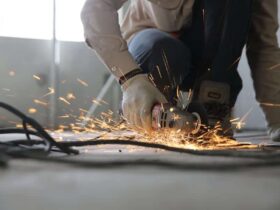To determine if ceiling tiles contain asbestos, hire a licensed professional for testing. The presence of asbestos in ceiling tiles can only be confirmed through laboratory analysis of a sample.
Asbestos fibers are harmful when disturbed, so it’s crucial to take precautions. In this blog, we’ll discuss the potential risks of asbestos in ceiling tiles, how to identify them, and the steps to take if asbestos is found. Understanding the signs of asbestos in ceiling tiles is essential for ensuring a safe and healthy indoor environment.
Whether you’re a homeowner or a building manager, being aware of the presence of asbestos is critical for making informed decisions about the safety of your space.

Credit: leadlab.com
Identifying Asbestos In Ceiling Tiles
Easily identify asbestos in ceiling tiles by hiring a professional for testing. Look out for signs like age, condition, and texture of the tiles. Prioritize safety by seeking expert advice if in doubt.
Visual Clues
Ceiling tiles that contain asbestos may have visual clues that can help identify their presence. One of the most significant characteristics of asbestos-containing ceiling tiles is their age. Asbestos was widely used in building materials until the 1980s. So, if your ceiling tiles were installed before the 1980s, there is a high probability that they contain asbestos. Additionally, asbestos-containing tiles are usually thicker and heavier than other tiles. They may also have a rough, gritty texture and a grayish-white color.
Characteristics
Another way to identify asbestos-containing ceiling tiles is by their characteristics. Asbestos fibers are incredibly durable, heat-resistant, and fire-resistant, which is why they were commonly used in building materials. If you suspect your ceiling tiles contain asbestos, you can look for specific characteristics like:
- Cracks or damage to the tiles may release fibers into the air.
- Asbestos fibers are microscopic, so they cannot be seen with the naked eye.
- The fibers are odorless and tasteless, making it impossible to detect them without proper testing.
- Asbestos fibers can stay in the air for long periods, making it easy to inhale them.
Common Patterns In Asbestos-containing Materials
Asbestos-containing ceiling tiles may have specific patterns that can help identify their presence. These patterns include a stippled or popcorn texture, which was popular in the 1970s and 1980s. Additionally, many asbestos-containing tiles have a square or rectangular shape and may have visible perforations on the surface.
If you suspect that your ceiling tiles contain asbestos, it is crucial to have them tested by a professional. Asbestos exposure can lead to severe health problems, including lung cancer and mesothelioma. So, it’s better to be safe than sorry!
Historical Context Of Asbestos Use
In the historical context of asbestos use, ceiling tiles were commonly manufactured with asbestos fibers. To determine if ceiling tiles contain asbestos, consider the age of the building and look for signs of wear or deterioration. Consulting a professional for asbestos testing is recommended for accurate results.
Timeline Of Asbestos In Building Materials
Asbestos has a long history of being used in various building materials due to its desirable properties such as heat resistance, durability, and insulation capabilities. However, it wasn’t until the 20th century that the potential health risks associated with asbestos exposure started to emerge. Here is a timeline highlighting key moments in the use of asbestos in building materials:
- 1900s: Asbestos becomes popular in construction due to its fire-resistant properties. It is used in insulation, roofing materials, flooring, and ceiling tiles.
- 1920s: The dangers of asbestos exposure start to be recognized, with cases of asbestos-related diseases being reported in workers who handled asbestos-containing materials.
- 1930s: Asbestos use continues to grow, with the material being used in a wide range of building materials, including ceiling tiles.
- 1960s: The link between asbestos exposure and diseases such as lung cancer and mesothelioma becomes more established. Concerns about the health risks associated with asbestos start to gain attention.
- 1970s: Regulatory measures are implemented to control asbestos use in building materials. The United States Environmental Protection Agency (EPA) and other regulatory bodies start issuing guidelines and regulations to protect workers and the general public.
- 1980s: Asbestos use begins to decline as more studies confirm its harmful effects. The use of asbestos in building materials, including ceiling tiles, starts to be phased out.
Regulations And Bans
Over time, as the dangers of asbestos exposure became more widely recognized, governments around the world implemented regulations and bans to protect people from its harmful effects. These measures aimed to limit the use of asbestos in building materials and ensure safe handling and disposal practices. Here are some key regulatory developments:
- 1970: The United States passes the Clean Air Act, which grants the EPA the authority to regulate asbestos. This leads to the establishment of guidelines and regulations for asbestos-containing materials.
- 1989: The EPA issues the Asbestos Ban and Phase-Out Rule, which would have banned most asbestos-containing products. However, this ban is overturned in court, and only a partial ban is implemented.
- 1999: The European Union (EU) bans the use of asbestos in new buildings and sets limits on the amount of asbestos allowed in existing buildings.
- 2003: The World Health Organization (WHO) recommends a complete ban on the use of asbestos globally due to its health risks.
- Present: Many countries have banned or severely restricted the use of asbestos in building materials. However, some countries still allow limited use or have not fully implemented asbestos bans.
Understanding the historical context of asbestos use and the regulatory developments surrounding it is crucial when assessing the potential presence of asbestos in building materials, including ceiling tiles. By being aware of the timeline of asbestos use and the regulations in place, you can better evaluate the risks and take appropriate measures to ensure safety.
Health Risks Associated With Asbestos
Asbestos exposure can pose serious health risks, as it has been linked to various respiratory conditions and cancers. Understanding the implications of asbestos exposure is crucial for safeguarding the well-being of individuals and communities.
Understanding Asbestos Exposure
Asbestos exposure occurs when the microscopic fibers of asbestos are inhaled or ingested, leading to potential health hazards. These fibers can become trapped in the body, causing inflammation and scarring over time.
Long-term Health Implications
Long-term exposure to asbestos can result in severe health implications, including lung cancer, mesothelioma, and asbestosis. These conditions may not manifest until years after the initial exposure, making early detection and prevention essential.
Professional Asbestos Testing
Detecting asbestos in ceiling tiles is crucial for safety. Professional asbestos testing is the best way to determine if ceiling tiles contain harmful asbestos fibers. Hiring experts ensures accurate results and proper handling of any asbestos-containing materials found.
When To Call An Expert
If you suspect that your ceiling tiles may contain asbestos, it is crucial to reach out to a professional asbestos testing service. Attempting to identify asbestos on your own can be risky and may lead to exposure if not done properly. It is always better to be safe than sorry when dealing with a potentially hazardous material like asbestos.
What To Expect During Asbestos Inspection
During a professional asbestos inspection, the experts will take necessary precautions to ensure your safety. They will wear protective clothing, including masks, gloves, and coveralls, to minimize the risk of asbestos exposure. The inspection process typically involves the following steps:
- Visual Examination: The inspectors will visually assess your ceiling tiles to identify any signs of asbestos-containing materials. They will look for specific characteristics such as color, texture, and appearance that may indicate the presence of asbestos.
- Sampling: If visual examination alone is not sufficient, the inspectors may take samples of the ceiling tiles for laboratory testing. These samples will be carefully collected using specialized tools and techniques to minimize the release of asbestos fibers into the air.
- Laboratory Analysis: The collected samples will be sent to an accredited laboratory for analysis. The laboratory will conduct various tests, such as Polarized Light Microscopy (PLM) or Transmission Electron Microscopy (TEM), to determine the presence and concentration of asbestos fibers in the samples.
- Reporting: Once the laboratory analysis is complete, the asbestos testing service will provide you with a detailed report of their findings. The report will include information on the type of asbestos, the concentration level, and recommendations for further actions.
Based on the results of the asbestos inspection, you will have a clearer understanding of whether your ceiling tiles contain asbestos. If asbestos is present, the experts will guide you on the appropriate steps to take for safe removal or containment of the hazardous material.
Remember, professional asbestos testing is essential to ensure your safety and the well-being of those around you. Don’t hesitate to contact experts if you have concerns about asbestos in your ceiling tiles.
Safe Handling Of Asbestos Materials
Safe handling of asbestos materials is of utmost importance to protect yourself and others from the health risks associated with asbestos exposure. If you suspect that your ceiling tiles contain asbestos, it is crucial to take precautionary measures and handle them with care. Here’s how you can safely handle asbestos-containing ceiling tiles.
Precautionary Measures
When dealing with ceiling tiles that may contain asbestos, it is essential to take the following precautionary measures:
- Wear protective clothing, including a respirator, gloves, and goggles, to minimize exposure to asbestos fibers.
- Minimize the release of asbestos fibers by wetting the tiles with a fine mist of water before handling them.
- Work in a well-ventilated area to reduce the concentration of airborne asbestos fibers.
- Restrict access to the work area and post warning signs to prevent accidental exposure.
Proper Disposal Of Asbestos-containing Tiles
Disposing of asbestos-containing ceiling tiles should be done in accordance with local regulations and guidelines. Here are the steps for the proper disposal of these tiles:
- Contact your local environmental or health department to inquire about the proper disposal procedures for asbestos-containing materials.
- Double-bag the tiles in heavy-duty plastic bags that are specifically designed for asbestos disposal.
- Label the bags as containing asbestos and handle them with care to prevent breakage or release of fibers.
- Transport the sealed bags to a designated hazardous waste disposal facility for safe and proper disposal.
Alternatives To Asbestos Ceiling Tiles
When it comes to renovating your ceiling, it is crucial to prioritize safety and avoid materials that may contain asbestos. Fortunately, there are modern substitutes for asbestos ceiling tiles that offer both aesthetic appeal and peace of mind. By opting for these alternatives, you can ensure a safe and stylish ceiling for your home or office. Let’s explore some of the popular options below:
Modern Substitutes For Asbestos
1. Fiberglass Ceiling Tiles:
Fiberglass ceiling tiles are an excellent alternative to asbestos. They are lightweight, durable, and resistant to moisture, making them suitable for various environments. Fiberglass tiles are available in a wide range of designs and can be easily installed, offering an attractive and safe ceiling solution.
2. Mineral Fiber Ceiling Tiles:
Mineral fiber ceiling tiles are made from a combination of natural minerals and binders. They offer excellent sound absorption, fire resistance, and thermal insulation properties. These tiles come in various textures and patterns, allowing you to achieve the desired aesthetic while ensuring a safe environment.
3. PVC Ceiling Tiles:
PVC (Polyvinyl Chloride) ceiling tiles are another popular alternative to asbestos. These tiles are lightweight, easy to install, and highly durable. PVC ceiling tiles are moisture-resistant, making them ideal for areas prone to humidity. They come in a wide range of colors and designs, offering versatility in design options.
Renovating With Safety In Mind
When renovating your ceiling, it’s essential to prioritize safety by following these guidelines:
-
- Identify and test existing ceiling tiles for asbestos: Before starting any renovation work, ensure that you identify and test the existing ceiling tiles for asbestos. This is especially important if your building was constructed before the 1980s when asbestos was widely used in construction materials.
- Hire a professional asbestos removal contractor: If asbestos is present in your ceiling tiles, it is crucial to hire a licensed asbestos removal contractor. They have the expertise and equipment to safely remove and dispose of asbestos-containing materials, ensuring minimal risk to you and your family.
- Choose alternative materials: Opt for modern substitutes, such as fiberglass, mineral fiber, or PVC ceiling tiles, to replace asbestos-containing tiles. These alternatives provide a safe and visually appealing option for your ceiling renovation.
- Ensure proper installation: Whether you choose fiberglass, mineral fiber, or PVC ceiling tiles, it is essential to follow the manufacturer’s instructions for proper installation. This will ensure that the ceiling is secure and meets safety standards.
By being aware of the alternatives to asbestos ceiling tiles and taking necessary precautions during renovation, you can create a safe and beautiful ceiling space that enhances the overall aesthetics of your home or office.
Frequently Asked Questions
How Dangerous Is Asbestos In Ceiling Tiles?
Asbestos in ceiling tiles is dangerous if it’s disturbed or damaged, releasing toxic fibers into the air. Exposure to asbestos can lead to serious health problems like lung cancer and mesothelioma.
How Do I Know If My Ceiling Tiles Contain Asbestos?
The only way to be sure if your ceiling tiles contain asbestos is to have them tested by a professional asbestos abatement contractor. You cannot tell just by looking at them.
Are All Ceiling Tiles From The 1970s And 1980s Asbestos-containing?
No, not all ceiling tiles from the 1970s and 1980s contain asbestos. However, it’s best to assume that any ceiling tile installed before 1990 contains asbestos unless it has been tested and proven otherwise.
What Should I Do If I Have Asbestos In My Ceiling Tiles?
If your ceiling tiles contain asbestos and are in good condition, you can leave them in place. If they are damaged or need to be removed, you should contact a professional asbestos abatement contractor to safely handle the situation.
How Much Does It Cost To Remove Asbestos From Ceiling Tiles?
The cost of removing asbestos from ceiling tiles depends on several factors, including the size of the area, the extent of the contamination, and the type of asbestos. On average, you can expect to pay anywhere from $1,500 to $3,000.
Can I Remove Asbestos From My Ceiling Tiles Myself?
No, it is not recommended to remove asbestos from your ceiling tiles yourself. Asbestos removal is a hazardous process that requires specialized equipment and training. It’s important to hire a professional asbestos abatement contractor to ensure the safety of yourself and others.
Conclusion
To sum up, identifying asbestos in ceiling tiles is crucial for safety. Regular inspection and testing are key. If unsure, consult professionals. Remember, early detection is vital for health protection. Stay informed and take necessary steps for a safe living environment.
Your well-being is worth the effort.








Leave a Reply